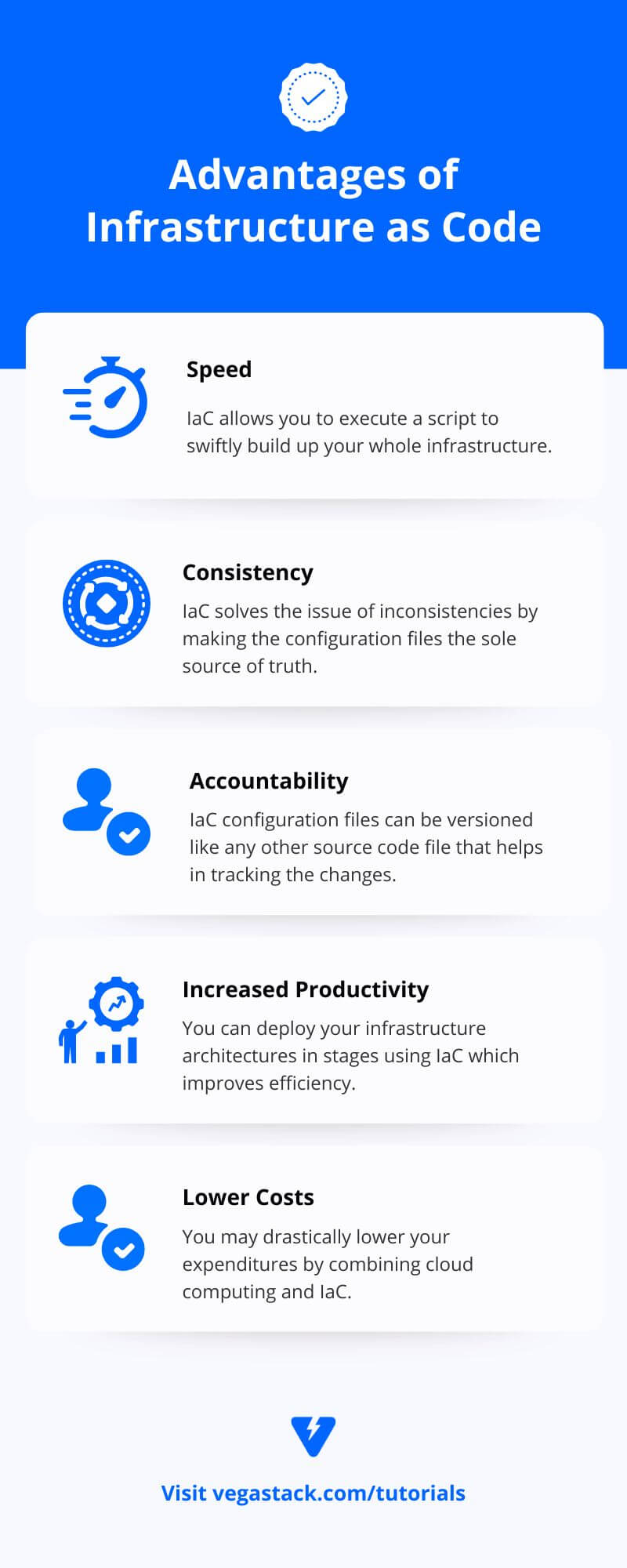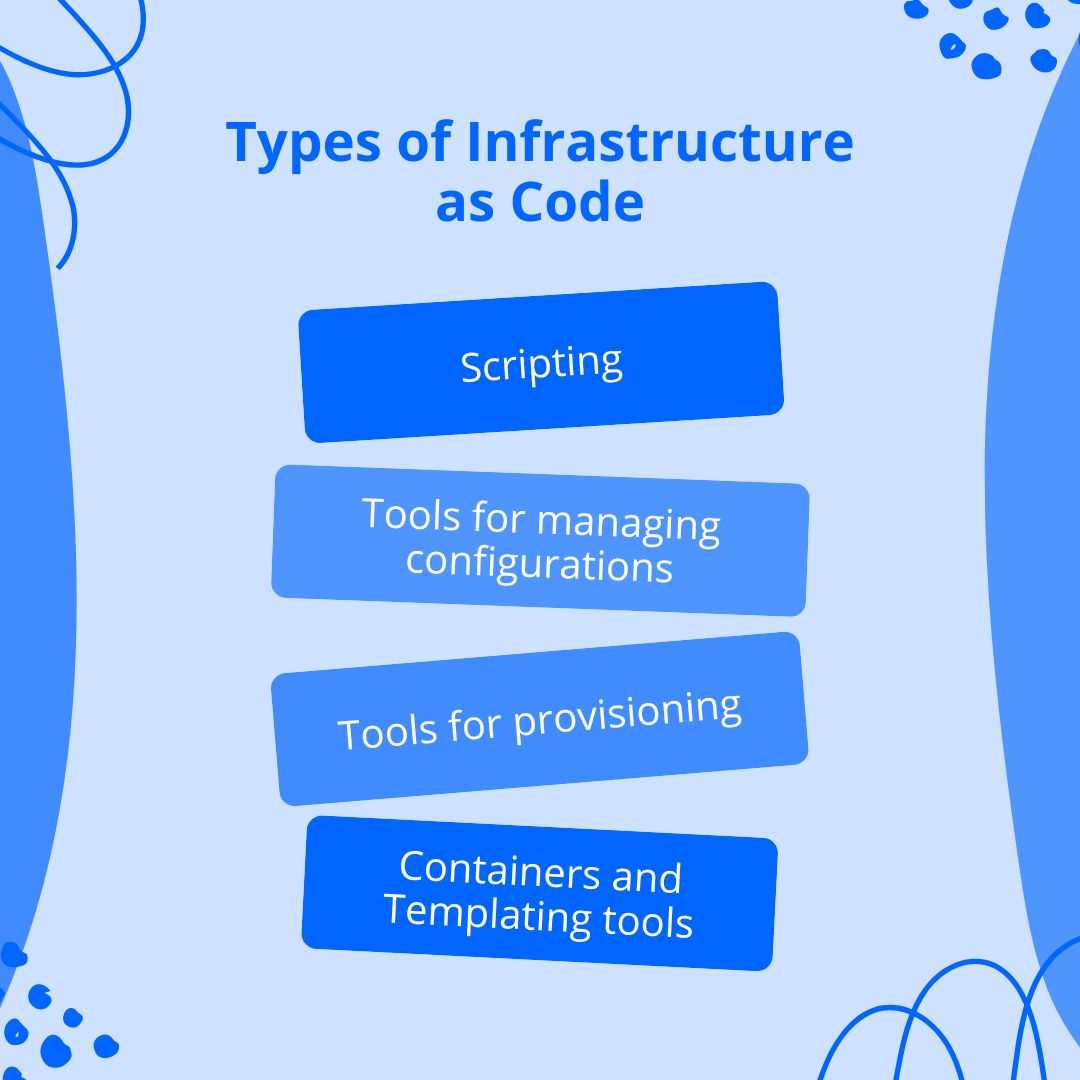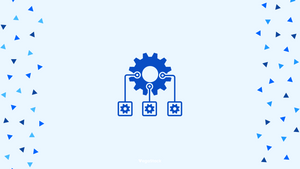Manual intervention was the sole technique to manage computer infrastructure for a long time. It was necessary to put servers on racks, install operating systems, and connect and configure networks. This wasn't a concern at the time because development cycles were so long that infrastructure changes were rare.
Later, however, a combination of technologies such as virtualization and the cloud, as well as the growth of DevOps and agile methodologies, drastically reduced software development cycles. As a result, better infrastructure management strategies were in demand. Organizations could no longer afford to wait for servers to be deployed for hours or days.
Infrastructure as Code is one method of improving infrastructure management and deployment time.
Understanding Infrastructure as Code
Infrastructure as Code (IaC) refers to the method of provisioning and managing infrastructure using code rather than a manual approach.

Because infrastructure is defined as code, users may quickly update and share configurations while guaranteeing that the infrastructure remains in the desired condition. This implies you can develop infrastructure setups that are repeatable.
Furthermore, describing infrastructure as code entails the following:
- Allows infrastructure to be readily linked into version control techniques, making infrastructure modifications trackable and auditable.
- Provides the ability to automate infrastructure management to a large extent. As a result of all of this, IaC is being integrated into CI/CD pipelines as a key component of the SDLC.
- Manual infrastructure provisioning and administration is no longer necessary. As a result, users can simply manage the underlying infrastructure's and configurations' unavoidable config drift while keeping all environments inside the intended configuration.
Declarative vs Imperative Infrastructure as Code
When it comes to writing code with IaC tools, there are two distinct ways. Declarative and imperative are the two methods. To put it another way:
- Imperative Approach: Users can describe the specific steps to be done for a change with an imperative approach, and the system will not deviate from those steps.
- Declarative Approach: A declarative approach simply means that users only need to declare the final demand, and the tool or platform will take care of the procedures necessary to fulfill that requirement.
In most infrastructure management use cases, the declarative method is chosen since it provides more flexibility while managing infrastructure.
IaC vs IaaS
It's important to note that IaC is not the same as infrastructure as a service (IaaS). They are two distinct ideas.
- Infrastructure as a Service (IaaS) is a cloud service that provides virtualized computing resources such as servers, networking infrastructure, storage, and so on.
- Infrastructure as Code (IaC) is a tool for provisioning and managing infrastructure. It isn't restricted to cloud-based resources solely. In fact, you use IaC in a variety of settings, including on-premises ones.
When & How to use Infrastructure as Code
IaC may appear to be superfluous for infrastructure requirements that are simpler and less sophisticated, however, this is not the case. Infrastructure as Code should be used to manage infrastructure in any—every—modern software development pipeline.
Besides, the benefits of IaC greatly outweigh the costs of installation and management.
Advantages of IaC
The following are the most important advantages of IaC:
- Speed: The first notable advantage of IaC is its quickness. Infrastructure as code allows you to execute a script to swiftly build up your whole infrastructure.
You can accomplish this for every environment, from development to production, and everything in between, including staging, QA, and so on. IaC can improve the efficiency of the entire software development lifecycle. - Consistency: Manual processes inevitably result in errors. Humans are prone to making mistakes. We have a problem with our recollections, communication is difficult, and we are generally poor at it.
Manual infrastructure management, as you've seen, will always result in inconsistencies, no matter how hard you try. IaC solves this issue by making the configuration files the sole source of truth. That way, you can be sure that the identical setups will be used over and over again, with no differences. - Accountability: IaC configuration files can be versioned like any other source code file, you can track the changes that each configuration has undergone. There will be no more guessing as to who did what and when.
- Increased Productivity Throughout the Software Development Cycle: You can deploy your infrastructure architectures in stages using infrastructure as code. This improves the efficiency of the entire software development life cycle, allowing the team to achieve new levels of productivity.
Programmers might use IaC to design and launch sandbox environments, allowing them to work safely in isolation. The same can be said for QA specialists, who may conduct their tests in exact replicas of the production environments. Finally, when it's time to deploy, you can do it in one step, pushing both infrastructure and code to production. - Lower Costs: One of the most significant advantages of IaC is the reduction of infrastructure administration costs. You may drastically lower your expenditures by combining cloud computing and IaC.
Because you won't have to spend money on hardware, hire people to run it, or build or rent physical space to hold it, you'll save money. However, IaC lowers your costs in a different, more subtle way, which we call "opportunity cost."
You see, having skilled, well-paid experts execute jobs that could be automated is a waste of money. Their whole attention should be on jobs that add more value to the company. That's where automation solutions, such as infrastructure as code, can help.

When to use IaC
Are you unsure when it's OK to employ IaC? When you have to handle any form of infrastructure, the simplest solution is whenever.
The particular needs and tools, on the other hand, make it more complicated. Some projects will have tight infrastructure management, while others may necessitate both infrastructure and configuration management.
Then there are platform-specific considerations to consider, such as if the tool offers the required feature set, security implications, integrations, and so on. Furthermore, people prefer a basic and clear product to a complex one, therefore the learning curve comes into play.
Below is a list of tools based on their intended use cases.
- Infrastructure Management: Terraform, Pulumi, AWS CloudFormation, Azure Resource Templates.
- Configuration management with somewhat limited infrastructure management capabilities: Ansible, Chef, Puppet.
- Configuration management: CFEngine.
In most cases, one tool may not be sufficient. Terraform, for example, might be great for managing infrastructure across numerous cloud environments, but it's limiting when it comes to in-depth customizations. Users can use a tool like Ansible to perform the necessary setups in these types of circumstances.
Similarly, users can mix and match any IaC tool in their CI/CD pipelines based on their specific needs.
How Infrastructure as Code Works
From a high level, infrastructure as code can be explained in three simple steps and shown using the graphic below:
- The infrastructure definition is written in a domain-specific language by developers.
- The files are then transferred to a master server, management API, or code repository.
- The platform automates the process of creating and configuring computer resources.
Types of Infrastructure as Code
Developers can choose between four different forms of IaC:
- Scripting: The most straightforward approach to IaC is to write scripts. Ad-hoc scripts are ideal for carrying out simple, quick, or one-time actions. However, for more complicated configurations, it's recommended to choose a more specialized option.
- Tools for managing configurations: These specialized tools, often known as configuration as code, are developed to manage software. Typically, they concentrate on setting up and configuring servers. Chef, Puppet, and Ansible are examples of these tools.
- Tools for provisioning: Infrastructure creation is the focus of provisioning tools. Developers can describe accurate infrastructure components with these tools. Terraform, AWS CloudFormation, and OpenStack Heat are examples of this.
- Containers and templating tools: These programs create pre-loaded templates or images with all of the libraries and components needed to launch an application. Containerized workloads are simple to distribute and have a fraction of the overhead of a full-size server. Docker, Rocket(rkt), Vagrant, and Packer are some examples.

Why does IaC matter for DevOps?
Implementing DevOps principles and continuous integration/continuous delivery (CI/CD) requires IaC. IaC relieves developers of the majority of provisioning effort by allowing them to run a script to have their infrastructure ready to go.
As a result, application deployments aren't stalled while infrastructure is built, and sysadmins aren't burdened with time-consuming manual processes.
From integration and testing through delivery and deployment, CI/CD relies on continuous automation and monitoring throughout the application lifecycle.
It is necessary for an environment to be consistent in order for it to be automated. When the development team delivers applications or configures environments one way and the operations team deploys and configures environments another, it's impossible to automate application deployments.
DevOps aligns development and operations teams, resulting in fewer errors, manual deployments, and inconsistencies.
As both teams can utilize the same description of the application deployment, IaC helps you align development and operations, supporting a DevOps approach.
Every environment, including your production environment, should employ the same deployment process. Every time IaC is utilized, it creates the same environment.
IaC also eliminates the need to manage multiple deployment environments, each with its own set of configurations that can't be replicated automatically, and assures that the production environment is consistent.
Learn Some Best Practices
We've put together a quick list of best practices to help you get the most out of your IaC strategy.
- Make code the only source of truth in your life. All infrastructure specs should be clearly coded in configuration files. For all of your infrastructure management concerns, your configuration files should be the single source of truth.
- All of your configuration files will be version-controlled. Put all of your configuration files under source control, which should go without saying.
- For your infrastructure specifications, use minimal documentation (or none at all). This point follows logically from the previous one. There should be no need for further documentation because your config files should be your only source of truth. External documentation can quickly become out of sync with actual setups, but this will not occur with config files.
- Your configurations should be tested and monitored. IaC is a type of code that, maybe tested like all other types of code. So you should put it to the test! You can check for faults and inconsistencies in your servers before deploying them to production by using IaC testing and monitoring tools.
Tools and Platforms for Infrastructure as Code
There are a variety of solutions available under the large IaC umbrella, ranging from dedicated infrastructure management tools to configuration management, open-source tools to platform-specific IaC alternatives.
Let's have a look at some of the most widely used IaC platforms and technologies.
Terraform
Terraform by HashiCorp is the main infrastructure as code (IaC) tool for managing infrastructure across a variety of platforms, including AWS, Azure, GCP, Oracle Cloud, Alibaba Cloud, and even Kubernetes and Heroku.
Terraform, as a platform-agnostic solution, may be used to automate any infrastructure provisioning and management use case across many platforms and providers while maintaining the desired state.
Ansible
Ansible is more of an open-source configuration management tool with IaC features than a dedicated Infrastructure management solution. Ansible works in both cloud and on-premises environments and may be used as an agentless tool via SSH or WinRM.
Ansible shines at configuration management and infrastructure provisioning, but it has limitations when it comes to infrastructure management.
Pulumi
Pulumi is a new tool that seeks to give an IaC experience that is focused on developers. Unlike other tools that require users to use a specific programming language or format, Pulumi allows users to use any supported programming language in any way they like.
The state is managed by default through the Pulumi service, which supports Python, TypeScript, JavaScript, Go, C#, and F#.
Chef/Puppet
Chef and Puppet are two configuration management systems with a lot of capability. Across the development pipeline, both attempt to provide configuration management and automation, as well as some infrastructure management.
- The chef was created to be readily incorporated into DevOps methods while also providing more collaboration features.
- Puppet came from a desire to automate as many operations as possible. Puppet now has built-in automated watchers for detecting configuration drift.
CFEngine
CFEngine is one of the most mature configuration management solutions available. CDEngine can meet even the most sophisticated configuration requirements, spanning everything from security hardening to compliance, despite the lack of capabilities to manage the underlying infrastructure.
AWS CloudFormation
AWS CloudFormation is a service provided by Amazon Web Services.
AWS' CloudFormation is a platform-specific IaC utility for managing AWS infrastructure. As a first-party solution, CloudFormation offers strong integration with all AWS services and can help with any AWS configuration.
Azure Resource Templates
Microsoft Azure facilitates IaC practices on the Azure platform by using JSON-based Azure Resource Templates. These resource templates keep the infrastructure consistent and may be used for any resource setup.
Aside from the aforementioned, there are specialized tools for specific infrastructure and configuration management tasks, such as:
- Packer, EC2 Image Builder, and Azure Image Builder are all tools for creating deployable custom operating system images.
- Cloud-Init is a cross-platform cloud instance initialization program that is widely used in the industry. When provisioning resources, it allows users to run the script (servers).
Conclusion
Servers, databases, services, virtual networks, permissions, block devices, and practically any other cloud provider offering may all be deployed and managed using Infrastructure as Code.
IaC is regarded as one of the most important DevOps and Agile software development practices.



